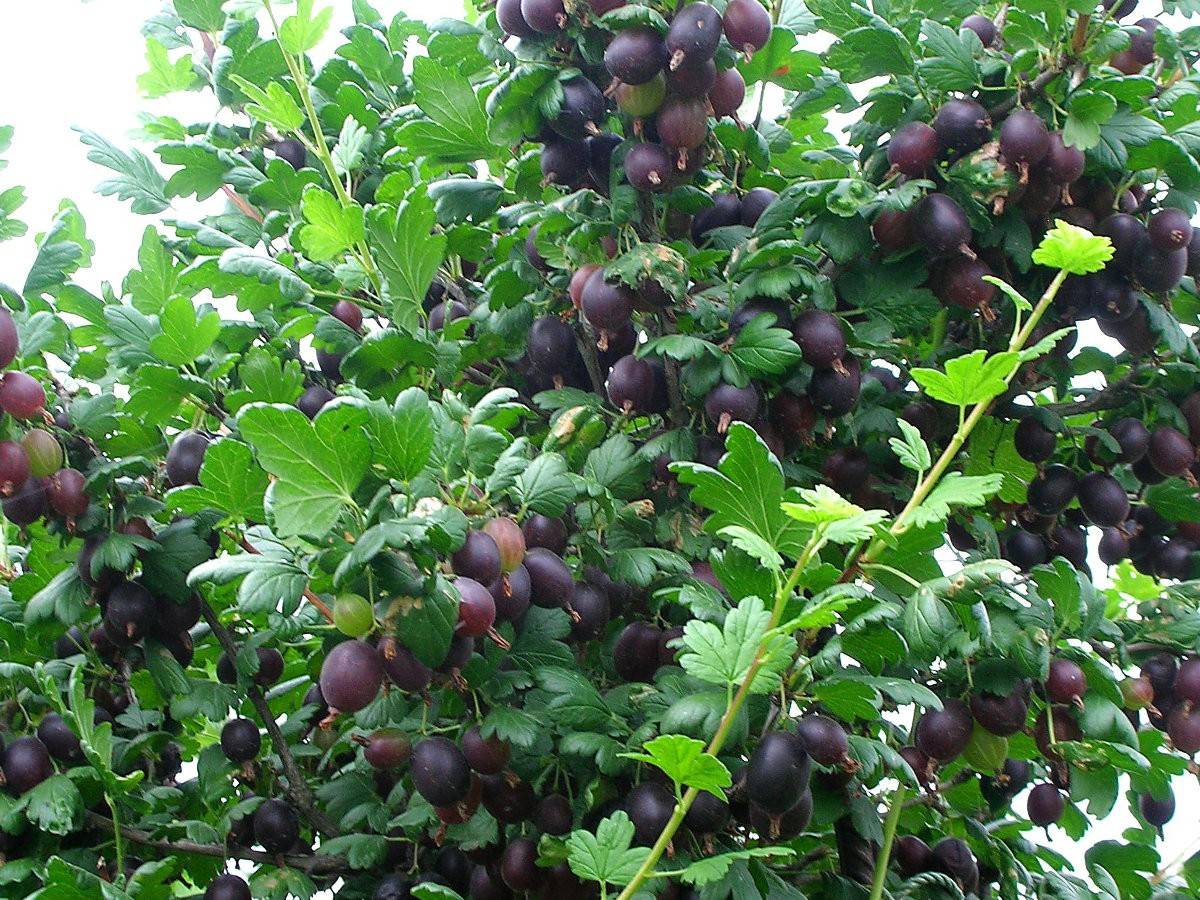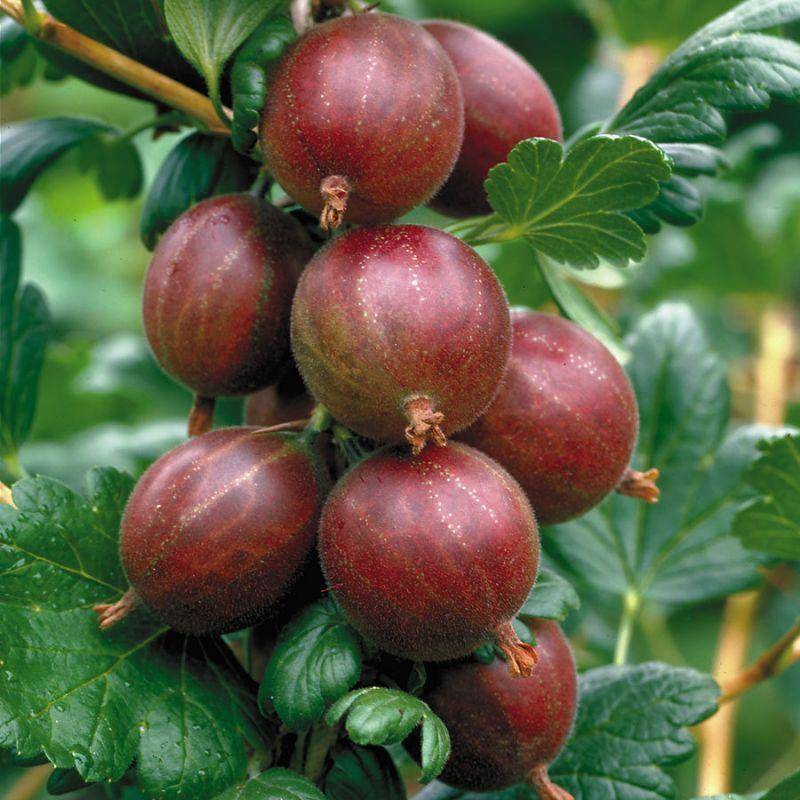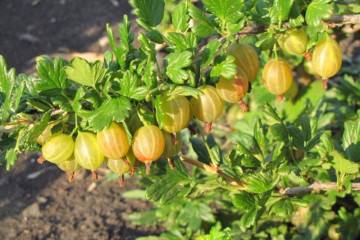Gooseberry Commander - features and characteristics
Content:
Gooseberry is an unpretentious plant that is perfect for growing in the garden and in the country. He will not only decorate the site, but will also delight you with a delicious healthy harvest.
Origin history and description
Gooseberry Commander (Vladil) was bred in 1995 at the Research Institute of Fruit and Potato Growing. The culture received its second name from the creator Vladimir Ilyin. To obtain it, such varieties of gooseberries as Chelyabinsk and African were used.
Description of the gooseberry variety Commander:
- Tall bush, slightly spreading, with thin shoots.
- There are no thorns on the branches.
- Leaves are dense and wide, bright green in color.
- Flowers are small, light green or pinkish, located in inflorescences of 2-3 pieces.
- The fruits ripen in mid-July and resemble balls in shape.
- Burgundy brown berries weigh up to 4.5-5.5 grams.
- The skin on the berries is dark, the flesh is raspberry-colored.
- The seeds are black and small.
Gooseberry Vladil is able to withstand frosts down to -35 degrees even without shelter, but experienced gardeners still insulate the bush for the winter. It can also withstand short-term drought, but if the gooseberries are not watered for more than a week, it will have a bad effect on the future harvest.
Using berries
Berries are used to make jams, compotes, jams, and also just enjoy them. In addition to its taste, the Commander (Vladil) gooseberry is very useful. It contains such elements as:
- vitamins C, P, A;
- folic acid;
- B vitamins;
- calcium, potassium, sodium, iron, iodine.
Advantages and disadvantages
Like all plants, Vladil (Commander) gooseberry has its pros and cons.
The advantages include:
- good yield;
- universal use of berries;
- lack of thorns on the plant;
- immunity to some fungal diseases and pests;
- high frost resistance and drought resistance.
Among the disadvantages are:
- resistance not to all types of fungal diseases and pests;
- fresh fruits do not last long.
Disease and pest resistance
The commander is resistant to some fungal diseases (powdery mildew, late blight, anthracnose) and pests (firefighter and sawfly).
Gooseberry is not resistant to:
- gray rot;
- ticks;
- mosaic disease;
- drying out of the stems;
- rust;
- white spot;
- aphids;
- glass case;
- gall midge.
Planting young seedlings on the site
When selecting seedlings, one should first of all pay attention to the rhizome. It should have 2-3 strong shoots up to 25-30 cm high. The bush should be without leaves, axillary buds should be dormant. The trunk should be gray with no light or dark blotches.
Gooseberries are planted in spring or autumn. In the spring, planting of seedlings begins before sap flow and swelling of the buds begin, and in the fall, 2-3 weeks before the first frost.
The holes are dug at a distance of 1 m from each other. The size of the holes is 60x50 cm. The top layer of soil from each hole is mixed with about 10 kg of compost, 1 spoon of superphosphate and 10 kg of sand.With this mixture, the depression is filled by a third and filled with water, after which the hole is left for 3-4 hours.
The place for the gooseberry should be chosen taking into account the lighting and humidity. The composition of the soil does not play a decisive role, but the groundwater should be no closer than 1.5-2 m from the surface of the earth. The acidity of the soil is allowed in the range of 5-7 pH.
Prepare a place for planting gooseberries six months in advance. To do this, the site is cleared of various debris, the soil is dug about 50 cm deep.
Planting process:
- the seedling is located in the center of the hole, its roots are neatly distributed. It is necessary to ensure that the root collar is deepened by 5 cm;
- the hole is covered with soil;
- the plant should be watered with plenty of water;
- the soil around the bush is mulched.
Features of seasonal care
Depending on weather conditions, watering is carried out 1-3 times a month, using about 20 liters of water for each bush. After planting, the plant does not need feeding, but for 2 years of life, they are carried out 2 times per season. In autumn and spring, gooseberries are sprayed with copper sulfate.
Loosening of the soil is carried out immediately after moistening, and in order to keep the moisture longer, the mulching method is used with hay, fresh grass or compost
As a rule, supports should be installed immediately after planting. This is done so that in the future the branches of the bush do not break under the weight of the fruit. Poles that are bifurcated at the top or those purchased from a hardware store can be used as support.
After planting for 3-4 years, the shoots on the bushes are shortened by 20-30 cm. This must be done before the buds swell. Pruning promotes the formation of lateral growths on the branches. Of these, the most developed are chosen, and all others are removed. After 4 years, only those branches that thicken the crown are pruned. With increasing age, gooseberries begin to rejuvenate, cutting off 3 poorly fruiting shoots.
Preparing for winter
Before wintering, a number of preparatory procedures are carried out: 3 weeks before frost, gooseberries are sprayed with copper sulfate. A few days after this procedure, the plant is watered using 20-30 liters of water. The next day, add top dressing, and then mulch the soil well and cover the bush with agrofibre.
Reproduction methods
Gooseberries can be propagated in several ways - by cuttings, dividing the bush, layering. Cuttings are used if they want to diversify the gooseberry varieties on the site. Cuttings are cut from the mother bush, which must be at least 8-10 years old. Otherwise, the cuttings will root poorly.
It is better to divide the bush in the fall. This contributes to a good harvest next summer. Gooseberries are propagated by division in the event that the plant is more than 10 years old, the bush has grown a lot, or there is a reason for transplanting an adult bush to a new place.
Reproduction by layering is the easiest and most affordable way. In addition, it does not cause stress in the bush, since the shoots are planted with an already developed root system. Very often, the layers themselves sink to the ground and are attached to it by roots, and the gardener only has to plant them from the mother bush in time and take proper care of them. If this does not happen, you need to bend the shoot to the ground yourself and fix it. After a while, roots will appear on it and young shoots will grow.
The gooseberry will certainly thank the gardener for the correct and timely care with a good harvest of tasty and healthy berries.




















